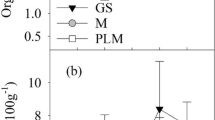Abstract
During the dry season in the tropics, agriculture which is solely dependent upon rainfall as its source of water is frequently affected by soil moisture stress, resulting in crop failures. Farmers therefore depend mainly on other sources of limited water supply during this period, such as ground water. Soil moisture conservation measures, especially surface mulching with loppings and, occasionally, leaf litter and crop residues, are practised. Our objective was to study the decomposition and nitrogen (N) release from these plant materials under continuously wet, low moisture regimes, i.e. comparable to those which prevail in the mulches used in the agriculture. A greenhouse experiment was conducted with fresh, chopped leaves of six leguminous trees, wild sunflower and rice, which were spread as a mulch on a layer of soil. They were maintained at eight moisture levels (a total of between zero and 43l water m–2 applied over 8 weeks) by spraying water. Different optimal moisture requirements for the rapid decomposition of these species were observed. These were presumably determined by different physical and chemical properties of the leaves. The amount of water received to the mulches and their soluble polyphenolic and carbon (C) concentrations played an important role in determining the decomposition and the mode of N release under non-limiting conditions of leaf N. Specifically, the C concentration governed N release, while the effect of polyphenolics was important when their concentration was low, as a result of leaching under relatively high moisture regimes. Leaves with a high polyphenolic and C content, which were subjected to high leaching losses of these fractions, underwent a change in their N dynamics from net immobilization to mineralization. This study indicates that leaves with a fast rate of decomposition should be mixed with other species, leaves which decompose more slowly in order to increase the conservation of soil moisture and also improve the synchronization between N release from the mulch and its demand by crops.
Similar content being viewed by others
Author information
Authors and Affiliations
Additional information
Received: 6 January 1997
Rights and permissions
About this article
Cite this article
Seneviratne, G., Van Holm, L. & Kulasooriya, S. Quality of different mulch materials and their decomposition and N release under low moisture regimes. Biol Fertil Soils 26, 136–140 (1997). https://doi.org/10.1007/s003740050356
Issue Date:
DOI: https://doi.org/10.1007/s003740050356




